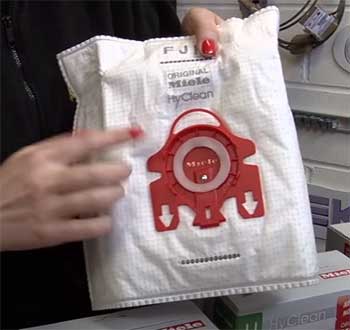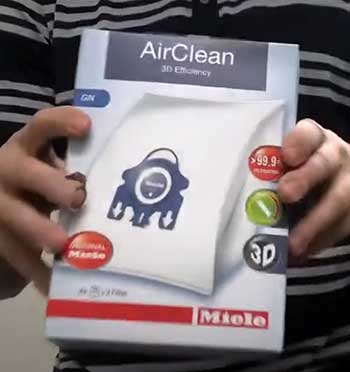When it comes to high-end vacuum cleaners, few brands can compete with Miele. This German manufacturer has long been known for making some of the best performing and most durable vacuums on the market.
A key component of any Miele vacuum is the dust bag, which is responsible for collecting all the dirt, dust, and debris picked up by the vacuum.
Miele offers two main types of dust bags – HyClean and AirClean. Both are high quality bags that do an excellent job trapping dust and particles. However, there are some differences between the two that are important to understand before choosing which one to buy.
This article will provide a comprehensive comparison of Miele HyClean and AirClean vacuum bags. We’ll examine the key features of each, pros and cons, and help you determine which type best suits your needs.
Key Differences At A Glance
Before diving into the details, here is a high-level overview of how HyClean and AirClean bags differ:
| Feature | HyClean | AirClean |
| Filtration | Hospital-grade HEPA filter built-in | Uses exhaust filter in vacuum |
| Dust Capacity | Holds 20% more dust | Holds slightly less dust |
| Odors | Carbon layer prevents odors | No odor control |
| Particles | Traps 99.9% of dust and allergens | Traps 99.3% of particles |
| Cost | More expensive | Less expensive |
Key Differences Between Miele HyClean And AirClean Vacuum Cleaner Bags
Now let’s explore each of these key differences in more depth.
- Filtration Systems

One of the biggest differences between HyClean and AirClean bags is the type of filtration system they use.
HyClean bags have an integrated HEPA filter built right into the bag itself.
This is a high-density filter that meets hospital-grade standards for trapping dust, allergens, and other fine particles.
The bag filters out particles as small as 0.3 microns in size with 99.9% efficiency. This includes things like mold spores, pet dander and dust mites.
AirClean bags rely on the exhaust filter built into the vacuum cleaner for filtration. AirClean bags trap larger debris and particles as the air passes through the bag. But the exhaust filter is what captures the smaller allergens and fine dust.
Most Miele vacuums use an AirClean exhaust filter that filters 99.3% of particles.
So in summary:
- HyClean has superior filtration built into the bag
- AirClean depends on the exhaust filter to catch small particles
If you have allergies or want the very best filtration, HyClean is the way to go.
- Dust Capacity
Another difference between the two bag types is dust capacity.
HyClean bags are able to hold significantly more dirt and debris before needing to be changed compared to AirClean bags. Miele states that HyClean bags have approximately 20% more capacity than AirClean.
This greater capacity comes from the unique structure of the HyClean bag. It has a star-shaped opening and is made of a special laminated microfiber material. This allows more air to flow through while maximizing dust storage.
AirClean bags use a more traditional bag design which holds slightly less dust than HyClean. However, AirClean bags are still very effective and suitable for most cleaning needs.
If you have a large home or shed a lot of dirt and debris, the extra capacity of HyClean will allow you to vacuum more before changing the bag. This can mean fewer interruptions to your cleaning routine.
- Odor Control

Pet odors, musty smells from dirt buildup, and other unpleasant odors can accumulate in vacuum bags over time.
Miele’s HyClean bags are designed to prevent these odors.
HyClean bags have an activated charcoal layer inside the bag that absorbs odors and prevents them from escaping back into the air.
This keeps the exhaust air from the vacuum smelling fresh.
AirClean bags do not have any odor control properties. Any odors present will pass through the bag and return to the room when the vacuum is running.
If odor control is important to you, the integrated charcoal layer makes HyClean bags the better choice. This is especially beneficial for pet owners or those with odor issues.
- Particle Filtration Efficiency
As mentioned earlier, HyClean and AirClean bags differ in how efficiently they can capture dust and allergens.
HyClean bags filter out 99.9% of particles 0.3 microns and larger. This includes fine dust and allergens that can aggravate allergies and asthma.
AirClean bags have a filtration efficiency of 99.3% for particles of all sizes. While still very good, the filtration isn’t quite as thorough as with HyClean.
For most people, the small difference in filtration won’t be noticeable. But if someone in your home has severe allergies, the HyClean’s superior particle capture could be beneficial.
Also Read: Is Laresar Better Than Dyson Vacuum Cleaner?
- Cost Differences
The advanced technology and materials used in Miele’s HyClean bags come at a price – they are more expensive than AirClean bags.
HyClean bags typically cost around 20-30% more than AirClean bags of the same size. However, the extra cost may be worth it for the added benefits of better filtration, increased dust capacity, and odor control.
AirClean bags provide excellent filtration and dust retention for less money. The savings over HyClean bags can be significant if you change bags frequently.
Ultimately the type of bag you choose will depend on your budget and cleaning needs. HyClean bags are the premium choice, while AirClean offers great performance for less.
Uses and Recommendations

Now that you understand the key differences between HyClean and AirClean, here are some recommendations on when to choose each bag type:
- Use HyClean bags if you:
- Have allergies – the superior filtration traps more allergens
- Have odor issues from pets or dirty carpets
- Need extra dust capacity for large homes
- Want the best filtration possible
- Budget allows for the higher cost
- The AirClean bags are a great choice if you:
- Have a smaller home without excessive dirt or dust
- Empty the bag frequently
- Don’t have problems with allergies or odors
- Want to save money on bags
Both Miele HyClean and AirClean bags are excellent quality and trap dust effectively. HyClean offers maximum filtration and odor control, while AirClean provides great performance for less. Choose the Miele vacuum bag type that best matches your needs and budget.
Also Read: Comparison of Dyson And Belife Cordless Vacuum Cleaners.
Frequently Asked Questions (FAQ)
The main differences between Miele vacuum bags are:
Filtration: HyClean bags have a HEPA filter built-in, AirClean bags rely on the vacuum’s exhaust filter
Dust Capacity: HyClean holds 20% more dust than AirClean
Odor Control: Only HyClean uses activated charcoal to absorb odors
Particle Capture: HyClean filters 99.9% of particles, AirClean filters 99.3%
Cost: HyClean costs 20-30% more than AirClean
1. Red Miele bags are the HyClean type with superior filtration and odor control
2. Blue Miele bags are the AirClean type which cost a bit less but don’t have quite as high filtration or odor absorption
The main differences between Miele GN 30 and GN 50 bags are:
Size: GN 30 holds 3.5 liters of dust, GN 50 holds 5 liters
Compatibility: GN 30 fits smaller Miele vacuums, GN 50 fits larger full-size models
Price: GN 50 costs more since it’s a larger bag
But both GN 30 and GN 50 are available in AirClean and HyClean models.
Miele recommends changing the bag when it is 3/4 full for optimal performance. For average use, you’ll need to change Miele bags approximately every 1-2 months. If you vacuum heavily, you may need to change it more frequently. Check the bag regularly and change when mostly full.
Wrapping Up
Miele HyClean and AirClean vacuum bags are both excellent options for trapping dirt and debris. HyClean offers the very best filtration and odor control, while AirClean provides solid performance at a lower price point.
Take your specific needs like allergies, home size, odor control, and budget into account when deciding between these two Miele bag types. Either way, you can be confident you are getting an outstanding vacuum bag.
Miele sets the standard for filtration, convenience, and durability.
